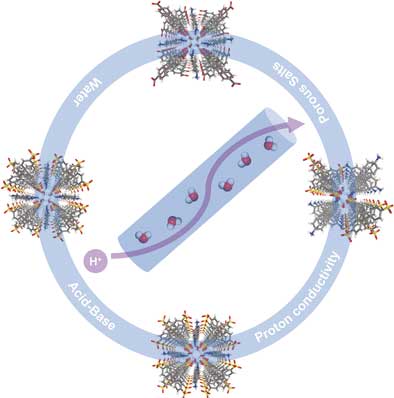| Apr 19, 2018 |
Porous salts for fuel cells
|
|
(Nanowerk News) Scientists have developed a new class of crystalline porous organic salts with high proton conductivity for applications such as proton-exchange membranes for fuel cells. As reported in the journal Angewandte Chemie ("Synthesis of Crystalline Porous Organic Salts with High Proton Conductivity"), polar channels that contain water play a critical role in proton conduction. At about 60°C and high humidity, their proton conductivity is one of the best yet found in a porous material.
|
|
Porous organic materials are potentially useful for many applications, including catalytic systems, separation processes, and gas storage. Although these framework-like structures vary greatly, they have one thing in common: their components are connected through covalent bonds.
|
|
Porous organic salts, on the other hand, are a new class of materials with components held together by ionic bonds, the attractive forces between positive and negatively charged ions. They are challenging to produce because their pores usually collapse; the ionic bonds of previously known organic salts are not strong enough to stabilize a porous structure.
|
 |
| Scientists have developed a new class of crystalline porous organic salts with high proton conductivity for applications such as proton-exchange membranes for fuel cells. (© Wiley)
|
|
Researchers working with Teng Ben at Jilin University (Changchun, China) have now successfully combined organic bases and acids to produce salts with very strong bonds and defined crystalline structures that form stable pore systems. These highly porous solids have the highest inner surface area ever found in an organic salt. The scientists demonstrated a significant correlation between the strength of the ionic bonds and the stability of the pore structure.
|
|
The pores in the salts form one-dimensional channels and can hold water. The water molecules are bound to each other and to the charged groups through hydrogen bonding. These aspects give the salts their unusually high proton conductivity. Materials with high proton conductivity have become the focus of attention because they are good electrolytes for fuel cells.
|
|
In a fuel cell, two half reactions of a chemical reaction occur while physically separated. The most popular version uses the reaction oxygen and hydrogen to form water. In this case, the two cells must exchange protons (positively charged hydrogen atoms) through an electrolyte--usually through a proton-conducting polymer membrane. Scientists have been searching for more efficient, robust electrolytes. These new salts may be candidates. They are very stable at higher temperatures and their proton conductivity increases as the temperature rises.
|
|
In conventional polymer membranes, proton transport occurs through water-containing channels through which the protons within the network are transferred from one molecule to the next through hydrogen bonded water molecules. In the salts, the transport mechanism is different. Calculations indicate that the protons are sent through the channels by "courier": A water molecule binds a proton and diffuses through the channel, releasing the proton on the other side.
|

